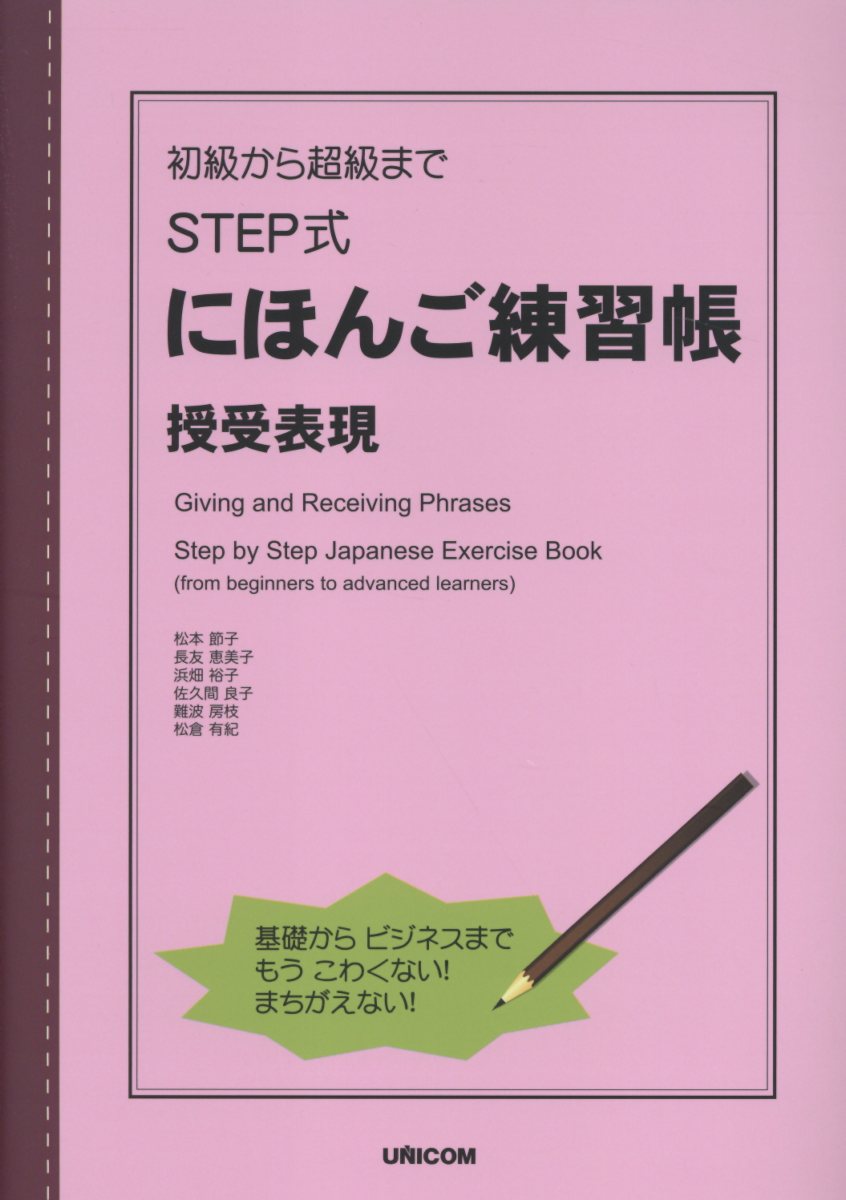內容簡介
內容簡介 <初級から超級までの、こんな方におすすめです> *初級の日本語を勉強中で、「あげます」「やります」「もらいます」「くれます」の表す人間関係・使い方がわからない方。 *中級以上の日本語力があるが、「~てあげます」「~てやります」「~てもらいます」「~てくれます」の表す人間関係・使い方がわからない方。 *上級以上の日本語力があるが、もう一度「授受の敬語表現」の復習がしたい方。 *他の日本語文法には自信があるが、「~てあげてもらう」「~てもらってください」「~てあげてくれませんか」のような3人以上の人が関係する授受表現に自信がない方。 *「授受表現」について、すべてを知りたい方。 *ニュアンスの違いを理解して、自然で誤解されない日本語を勉強したい方。 <STEP1~4の4段階で、自分の力に合ったレベルから、勉強できます> STEP 1 「あげます・やります」「もらいます」「くれます」 *わかりやすい図で、物の授受の表現方法や、人間関係を理解することを学びます。 *例文や練習問題は、初級の人にでもわかるように、「わかちがき」で書いてあります。 *例文や練習問題は、初級で使う漢字だけを使いました。 STEP 2 「~て あげます・~て やります」「~て もらいます」「~て くれます」 *わかりやすい絵で、行為のやりとりの表現方法や、人間関係を理解することを学びます。 STEP 3 「さしあげる」「いただく」「くださる」 *授受の敬語のシステムが、わかりやすく説明してあります。 *人間関係をスム―ズにするための敬語表現が身につきます。 STEP 4 たくさんの人が関係する授受表現 *3人以上の人が関係する授受表現を、絵で説明してあります。 *文の意味を深く理解する練習ができます。 *「教えてください」「教えてやってください」「教えてあげてくださいませんか」のような、微妙な違いがわかり、それぞれのニュアンスを理解することができます。 <「コラム」で比較できます> *コラム(column)では、「~ていただけます」「~ていただけますか」のような、間違えやすいフレーズが説明してあります。 <豊富な練習問題があります> *たくさんの種類の問題をしていくうちに自然に「授受表現」の使い方・意味の違いを覚えることができます。 *ひとつひとつ手で書く形式の問題が多いので、確実に「授受表現」を覚えることができます。 *丁寧に書き込んでください。書くときには必ず声を出しながら、書き込みましょう。目と耳と手を使ってしっかりと覚えてください。 <全部の説明文・例文には、英語の翻訳が付いています> *この本の英訳は、元の日本語がわかるように直訳してあるので、自然な英語ではありません。 *この本の「he」は「she、they」も表しています。 <This book is recommended for beginners to highly advanced level students> *For beginners who do not understand the usage of words like「agemasu」,「yarimasu」,「moraimasu」 and 「kuremasu」 or what they indicate about the relationships between the speakers. *For students who have mid level and above Japanese ability but do not understand the usage of phrases like「~te agemasu」,「~te yarimasu」,「~te moraimasu」,「~te kuremasu」 or what they indicate about the relationships between the speakers. *For students with advanced or higher Japanese language abilities but who want to review polite language in Giving and Receiving phrases. *For students who are confident about other aspects of Japanese grammar but have no confidence regarding what phrases like 「~te agetemorau」, 「~te moratte kudasai」,「~te agete kuremasen ka」 show about the relationships between three or more people. *For students who want to know all about Giving and Receiving phrases. *And for students who want to study how to speak natural Japanese without causing misunderstandings by truly understanding the differences in nuance. <You can study at a level determined by your own ability from STEPS 1 through 4> *STEP 1 「agemasu・yarimasu」 「moraimasu」 「kuremasu」 *You can learn expressions for giving and receiving things and understand the relationships between the people in a fun way by looking at easy to understand diagrams. *The example sentences and problems are written with spaces (“wakachigaki") so that even beginners can understand them. *Only beginners level Kanji are used for the example sentences and problems. STEP 2 「〜te agemasu・〜te yarimasu」 「〜te moraimasu」 「〜te kuremasu」 *You can learn expressions for doing things for other people as well as understand the relationships between the people in a fun way by looking at easy to understand pictures. STEP 3 「sashiageru」 「itadaku」 「kudasaru」 *The Giving and Receiving polite language system is explained in a simple to understand way. *You can learn how to make polite expressions to make relationships between people run smoothly. STEP 4 Giving and Receiving Expressions Relating to Many People *The Giving and Receiving expressions showing the relationships between three or more people are explained with pictures. *You can practice understanding the deep meaning of sentences. *You can understand the subtle differences between 「oshiete kudasai」, 「oshiete yatte kudasai」, and 「oshiete agete kudasaimasenka」 . <You can do many practice problems> *While you are doing the various problems you will naturally learn the usage of Giving and Receiving expressions and the difference in their meanings. *You will be able to properly learn Giving and Receiving verbs by the many problems that should be written out by hand. *Please write them out carefully. Be sure to sound them out as you write. Using your eyes, ears, and hands to learn. <English translations are provided for the explanations and example sentences> *The English is a direct translation in order to understand the Japanese and may not be natural English. *Japanese sentences often do not include pronouns, so the word “he" is used for both “she" and “they."
作者介紹
作者介紹 松本 節子 Setsuko MATSUMOTOJapanese Language & Culture Institute 代表長友 恵美子 Emiko NAGATOMOLecturer of the Lauder Institute (Wharton, Arts & Sciences) at University of Pennsylvania浜畑 裕子 Yuko HAMAHATA早稲田大学日本語教育研究センター 非常勤講師佐久間 良子 Yoshiko SAKUMAJapanese Language & Culture Institute言語文化部 レクチャラー難波 房枝 Fusae NAMBAテンプル大学ジャパンキャンパス Undergraduate Program非常勤講師松倉 有紀 Aki MATSUKURA青山国際教育学院 非常勤講師テンプル大学ジャパンキャンパス 生涯教育プログラム 非常勤講師
